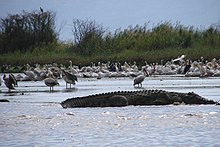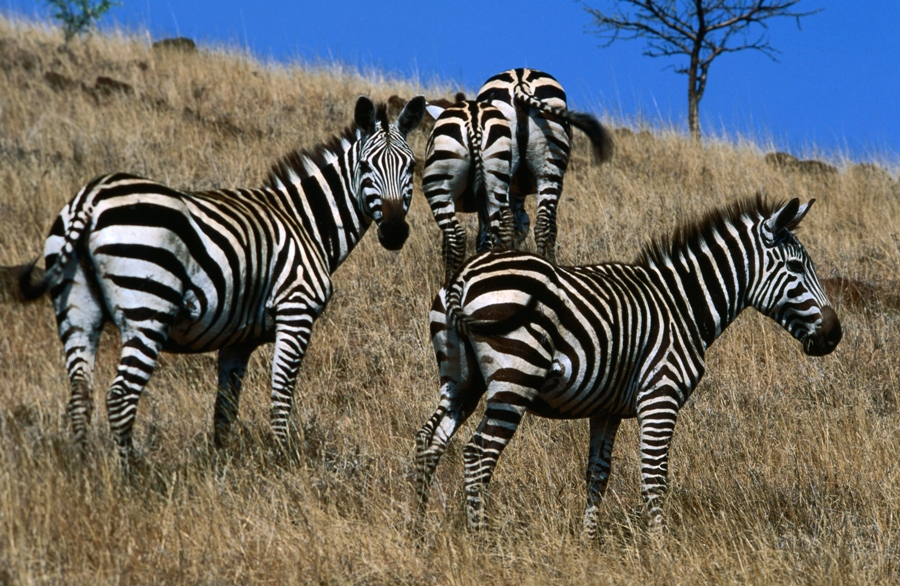Ethiopia Trip To Nechsar National Park
Nechisar National Park (also spelled as Nech Sar meaning white grass) is one of the National Parks of Ethiopia. Your Ethiopia trip to Nech Sar is takes you on a journey to the Southern Nations, Nationalities, and Peoples Region (SNNPR) immediately to the east of Arba Minch, its 514 square kilometers of territory, includes the “Bridge of God” (an isthmus between Lakes Abaya and Chamo), and the Nechisar plains east of the lakes.
Park elevations range between 1108 and 1650 meters above sea level. Nechisar National Park was established in 1974. The Ethiopia Trip to Nech Sar is ideal for nature lovers and those who seek adventure! To learn more about this National Park visit the links below.
| Contents 1. History and management 2. Geography and landscape 3. Wildlife |
History and management
As part of an UNESCO plan to protect and conserve nature and natural resources inside Ethiopia, a two man team of UNESCO consultants spent three months surveying most major wildlife areas in Ethiopia, and officially submitted to the Wildlife Conservation Board in 1965 their recommendations, which included a game reserve to the east of Lake Chamo to provide protection for the population of Swayne’s Hartebeest and other local wildlife. The Nechsar National Park was proposed in 1967, then officially established in 1974. Since then it has not legally been gazetted, but has functioned as de facto national park. Following the recommendations of the Ethiopian Ministry of Agriculture recommendation, in 1982 the local Guji, who had been living as pastoralists in the lowlands beside Lake Abaya and Chamo “were forcibly evicted from the park at gun point”.[4]


Lake Chamo
In the lawless period at the end of the Derg rule and immediately afterwards, Nechisar suffered much damage. Park buildings located far from the headquarters were looted and damaged. At the same time, the local Guji returned to their traditional grazing areas. According to one source, they fled there from the attacks of the Borena Oromo, who in turn were victimized by neighboring ethnic groups, their presence degrading the environment and contributing to the local extinction of many species. The Guji also acquired firearms during this period, and used them to resist eviction from the Park afterwards. In 2004/05, Refugees International criticized their eviction.
In 2005, the management responsibility for Nechisar National Park was handed over to APN. In consultation with the Ethiopian government and the SNNPR government they began attempting to address the problems with illegal operations in the park including the illegal cutting down of trees for firewood for Arba Minch, illegal fishing, illegal human settlement and cattle grazing inside the park. APN assigned a group of scouts to improve the protection of the area.
One of the major environmental concerns facing the park is illegal fishing operations on Lake Abaya and Chamo. According to Abera Adnew, deputy manager of Arba Minch Fishermen Cooperatives, “There are over 3000 illegal fishermen working on Lake Abaya,”. The Arba Minch Fishermen Cooperative has attempted to address the problem but has faced much hostility from the illegal fisherman who depend on the fish stocks for their livelihoods. The problem is enhanced by water recession from the shore during the dry seasons and the volume has been diminishing in the last few years as tributary rivers were diverted for irrigation. A tributary, the Kulfo River, which once had an abundant fish population has dried out considerably during dry season. Some farmers in the park have taken advantage of the dry land on the shores and have begun banana cultivation in recent years referred to the locals as “soke”.
The fishermens’ association is licensed to work on Lake Chamo as well, but aside from conflicts with the fishermen, they have also faced hostility from Guji pastoralists. APN attempted to directly negotiate with the Guji communities in the park and according to the manager of APN, “We managed to have an agreement with the Guji people by the end of September 2004,” John Mark said. The federal government requested a formal letter from the SNNPR government approving the negotiation between the Guji communities and African Parks. But the regional government would not approve the negotiation. That is the main reason why they are pulling out” [2]
While Tourism has increased in the park in recent years, doubling each year from 5300 tourists in 2005 to 20,500 in 2007, in October 2008 APN announced that they were ending management of Nechisar National Park. In a magazine article reprinted on their website, APN claims that sustainable management of the Ethiopian parks is incompatible with “the irresponsible way of living of some of the ethnic groups”. African Parks added that the emphasis for resettling inhabitants out of the Park, rather than educating them to work with them, came from the Ethiopian government. APN was told that the Guji were an Oromo people, and “they belong in the adjoining Oromiya province, not among the Gamo and Gofa peoples of the Southern District, where the park is”.
Geography and landscape
The important regional centre to the park is Arba Minch in the Main Ethiopian Rift. Approximately 15% of the park consists of lakes including Lake Abaya in the north and Lake Chamo in the south. Part of the habitat consists of the groundwater forest and shoreline of the lakes, but there are dry grassy plains, and most of the park is covered in thick bushland and the wooded valleys and foothills of the Amaro Mountains. The altitude ranges from 1,108 meters above sea level at the shore of Lake Chamo to 1,650 meters on Mount Tabala in the north-east, renowned for its hot springs.
The forest between the two lakes and by the Kulfo river is dominated by Ficus sycamorus which can grow up to 30m tall. Extensive areas to the west of Lake Abaya were cleared in the 1960s and 1970s to establish large-scale mechanized farms for cotton and other crops.


Dichrostachys cinerea
The freshwater swamps at the mouth of the Kulfo River and in Lake Chamo are dominated by Typha angustifolia, tall waterside grasses and the small leguminous trees, such as Aeschynomene elaphroxylon and Sesbania sesban. Taller trees found in the park include Dichrostachys cinerea, Acacia tortilis, Balanites aegyptiaca and less common Acacia nilotica. The southern part of the park is domainated by edaphic grassland and a calcareous black clay soil underneath with Dobera glabra, Acacia tortilis and the grass Chrysopogon aucheri forming much of the landscape.
Both Lake Abaya and Chamo have substantial fish populations, notably Nile perch, which forms the basis of the local fishing industry. Crocodiles inhabit both lakes and there is a crocodile farm near Lake Abaya. At Chamo crocodiles are exploited for their skins.
Wildlife


The park has a notable population of Grant’s Gazelle
Wildlife in the park include Plains Zebra, Grant’s Gazelle, Dik-dik, and the Greater Kudu as well as one of the last three populations of the endangered Swayne’s Hartebeest, endemic to Ethiopia. A stretch of the northwest shore of Lake Chamo is known as Crocodile Market, where hundreds of Crocodiles gather to sun themselves. The park also has populations of bushbuck, bushpig, Anubis baboon, vervet monkeys, black-backed jackal and Burchell’s zebra. The endangered Painted Hunting Dog, Lycaon pictus once existed in the Park (with last sightings at Fincha), but may now be extirpated due to human population pressures in this region.
Nechisar National Park is considered an important habitat for bird populations particularly those migrating. It has a noted population of kingfishers, storks, pelicans, flamingos and fish eagles.
Other birds include Falco naumanni and Circus macrourus, which are fairly common on passage, while small numbers of Phoenicopterus minor have been reported on Lakes Chamo and Abaya. Species typical of bushland habitats include Phoeniculus somaliensis, Lanius dorsalis and Cisticola bodessa and the open plains support three species that are very unknown elsewhere in Ethiopia: an isolated population of Mirafra albicauda, the endemic Caprimulgus solalaand the rare C. stellatus. The south-western corner of Lake Abaya supports one of only two Ethiopian populations of Myrmecocichla albifrons. Other species of note include Accipiter ovampensis, Aviceda cuculoides, Gypaetus barbatus, Macheiramphus alcinus, Chelictinia riocourii, Francolinus levaillantii, Podica senegalensis, Serinus reichardi, Schoutedenapus myoptilus, and Coracina caesia.




Comment (0)